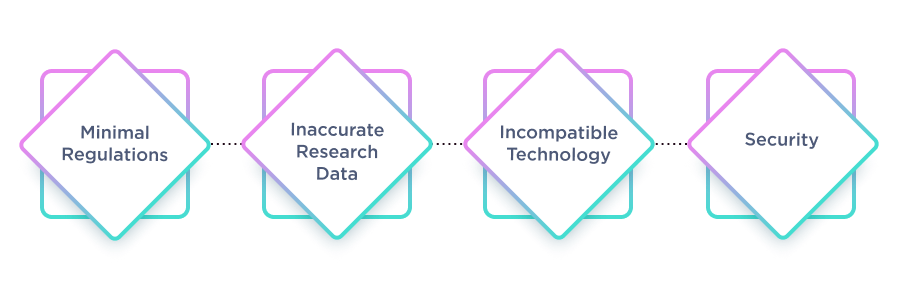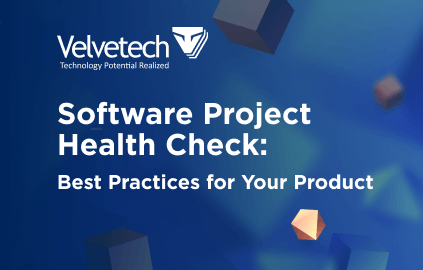Technology trends in healthcare can dramatically improve patients’ wellbeing but, if implemented poorly, may cause more problems than they solve. Yet, smart hospitals, clinics, and physicians are already flocking to application development as a way to strengthen trust and build their value proposition with increasingly tech-savvy patients.
So, if you are not thinking about healthcare application development yet, you probably should. However, before you get started, it might be interesting to look over some of the current technological trends in healthcare. Primarily because you may identify those that are of the highest interest to you and can bring your company relevant benefits.
Hence, in today’s post, we invite you to discover the digital trends that are impacting the health industry, learn about the pitfalls of developing mHealth apps, and find out how to start creating your solution.
Top Digital Trends in Healthcare App Development
At the base of the app revolution is improved patient health. Bells and whistles aside, real benefits are easily measured when smartphones enter the healthcare ecosystem. For instance:
Paramedics and EMTs rapidly gain access to life-saving information.
Hospital and clinic personnel can retrieve medical history records such as historic blood pressure readings, pulse/heart rate, known allergies, immunizations, even digital x-rays, medical histories, and case-notes.
Outpatients are reminded to take medications and return for follow-up appointments.
Hospital administration can notify and coordinate changing shift nurses about food intake, medication sensitivities, etc.
In short, with easy-to-use apps, patients can obtain information placed there by doctors, message a nurse to ensure day- and time-stamped communications (while avoiding phone-tag problems) and even schedule an in-person checkup.
Discover how we built a Medical Reference App for an Illinois Clinic
However, besides the power of mobile-friendly solutions, there are also many new technology trends in healthcare that should warrant your attention. So, let’s take a closer look at each one of them.

Artificial Intelligence
Artificial intelligence implementation is one of the most prevalent of the current technology trends in healthcare. Thanks to the algorithm’s ability to record, analyze, and interpret data, human efforts can be complemented, and the success of various medical procedures can be significantly improved.
To get a bit more specific, take a look at some of the top use cases of AI in healthcare:
- Robot assisted surgery: AI-powered robotic instruments can help complete precise, flexible motions.
- Clinical trials participation: to efficiently pinpoint the patients that are eligible with the aid of data science and natural language processing.
- Research and development: to help discover new medications for illnesses.
- Medical imaging and diagnostics: with computer vision technology and effective machine learning algorithms, medical images can be interpreted at a faster pace.
- Health predictions: AI-enabled software can forecast future ailments based on various medical data and recommend preventative measures.
Of course, these are just a few of the ways that AI can boost your healthcare organization. However, we hope they give you a good idea of the potential of this technology.
Read up on more Revolutionary AI in Healthcare Uses

Internet of Things
When discussing digital health trends, we can’t bypass the Internet of Medical Things.This technology allows for the creation of an ecosystem between connected devices and software solutions for collecting, transmitting, and analyzing data.
Thermometers, glucose meters, smart inhalers, blood pressure monitoring devices, and the like can all deliver highly specific data on a patients’ health. Then, this information can be analyzed to come up with personalized recommendations and treatment plans. Thus, allowing to improve the entire patient experience.
Additionally, connected devices benefit doctors who can make more precise diagnostics and stay on top of treatment adherence by monitoring the digital information that comes from wearables, ingestible sensors, and other devices.
Learn more about the Role of IoT in Healthcare

Blockchain
Blockchain implementation is another major trend within the medical field. One of the main benefits of this technology is that it is capable of significantly boosting your data security efforts. Since blockchain is essentially an immutable distributed ledger, it can facilitate the transfer of medical records in a way that keeps personal health information totally protected.
Another important use case of blockchain in healthcare is within pharmaceutical supply chain management. You see, pharma faces a lot of challenges, many of which stem from poor visibility of the global supply chain.
Luckily, blockchain can come to the rescue. Most notably, it provides the chance to ensure pharmaceutical product authenticity through data sharing and visibility into the entire product journey thanks to immutable records.

Telemedicine
The fourth technology trend in healthcare we’ll cover today is telemedicine. This one became particularly popular following the COVID-19 pandemic. As you may know, care providers had to quickly find ways of helping non-urgent patients remotely, and, as a result, many embraced IT and telecommunications.
In short, telemedicine is all about empowering healthcare practitioners with digital tools for distanced medical consulting, diagnostics, and treatment. Specifically, this approach includes conducting live-video consultations, monitoring data from wearables, and so on.
Find out why Telemedicine is Valuable for Patients and Medical Professionals

Augmented and Virtual Reality
Another one of exciting digital trends on the health market is the implementation of augmented and virtual realities (AR/VR). Whether to assist in surgery, improve telehealth applications, or facilitate training — there are multiple ways for AR and VR to positively impact the medical sector.
An excellent example of this technology is Microsoft’s mixed reality headset called HoloLens. It can be operated hands-free with simple gestures and voice commands, thus allowing surgeons to focus on the procedure while referring to more information than is usually available.
Besides helping in surgery, such headsets can also be great for training and facilitating collaboration between practitioners across various locations. With so much potential, it’s easy to see why AR and VR are gaining traction within the medical field.
Pitfalls of mHealth Apps
Now that we’ve covered the main digital trends in the health industry, it’s important to briefly touch on some pitfalls you might encounter when pursuing the development of mHealth apps.

1. Regulations are Minimal or Nonexistent
By touting benefits, mHealth apps can generate significantly more sales. Since no single body oversees efficacy of claims, end-users’ expectations may far exceed quantitative and qualitative accuracy.
The Food and Drug Administration has generally pursued a hands-off approach, having approved roughly one out of every 1,000 apps geared for the health and wellness consumers.
2. Inaccurate Research Data
Neither state nor federal government agencies have established guidelines for precision requirements regarding data collection, analysis, or reporting.
Private companies that share collected data are not held to a defined standard regarding accuracy, demographic diversity, or other types of quantifiable variables.
As a result, research studies are producing skewed results that can lead to bad public health policies and misguided planning by healthcare institutions.
3. Incompatible Technology
Some healthcare apps are created with newer programming languages; scanning, recording and reporting technologies. Problems crop up when a doctor’s office or hospital emergency room is not yet equipped to receive and integrate collected data.
Patients’ heart rates, cholesterol levels, and other vital signs, once collected, may be trapped in cyberspace, instead of serving the purpose of furthering proper treatment.
4. Security Can Be Compromised
Unless you’re extremely careful, it can be all too easy to run afoul of HIPAA (Health Insurance Portability and Accountability Act of 1996) regulations, designed to protect patients’ personal data.
Security should be the top priority when embarking on custom healthcare application development; not simply in respect of patients, but also to avoid potentially expensive penalties that can run between $100 and $50,000 per individual violation.
Learn how to build a HIPAA-Compliant Application
Project Health Check
Learn the actionable steps to keep your software project on the right track, aligned with your initial goals and designated priorities.
How to Start Creating an App
Finally, you’re up-to-date with all of the top technology trends in the healthcare industry and aware of the challenges that you might face. The only thing that’s left to do is discuss the process of developing your application.

1. Figure Out Your Strategy
First, decide which market you want to serve within the broad category of “healthcare”. Or, what issue you’re trying to solve within the business. Whatever the case may be, there are multiple software subcategories that may suit your needs. Take a look:
Patient App Usage Examples
- General Wellness
- Nutrition / Diet
- Managing existing medical conditions
- Fitness
- Compliance
- Alerts / Reminders for medications or appointments
- Monitoring and remote consultation
Professional Healthcare Worker Usage Examples
- Medical records – storage and retrieval of prescriptions, digital image scans, etc.
- Information & time management (setting appointments and meetings)
- Consultative communication (messaging, voice/video, social networks)
- Research medical literature – available medications, CDC reports, and medical news – that affects broad populations
- Data aggregation / review to interpret test results, diagnose, examine lab research
- Monitoring of patients’ symptoms, rehab routine adherence, etc.
- Education – prepare for tests, read studies / medical journal articles, etc.
Choosing a Winning App Development Strategy
Watch our webinar to uncover effective mobile development approaches and launch your app.
2. Plan Your Process
Figure out what specific actions you want your solution to perform and note them down. Then, develop a comprehensive product roadmap so that you can zero in on the specific goals you’ve set and ensure they’re met at the end of the project.
Lastly, identify the skills you need for the undertaking. Are you building an iOS app or an Android solution? Or, perhaps you’re more interested in web-based software. Whatever the case may be, you’ve got to figure it out at this stage.
If you’re having trouble — consider reaching out to experienced software development experts. They’ll be able to consult you on the appropriate technology stack and even take the work off of your hands if needed.
3. Design Your Solution
At this point, it’s time to create an intuitive, user-friendly, and engaging UI/UX design. Whether you choose to do it yourself or outsource to a partner, this is when the team will create the app’s information architecture, workflow diagrams, wireframes, style guides, and prototypes.
4. Develop the Software
Once the design phase is complete, you will move on to the main part of the application development process. This is when your solution will actually start to come to life and take shape. Naturally, you don’t want to rush this part of the project as it is fundamental to what the final result will look like.
5. Testing and Deployment
Before you deploy the app, run a couple of tests to make sure that the developed software is stable, secure, and without any bugs. Specifically, you should carry out functionality, performance, security, platform, and device testing. That way, you’ll likely avoid any unpleasant surprises.
Once that’s done, you are free to deploy your solution within your internal infrastructure or through the appropriate distribution models. It all depends on the type of software you’ve set out to build and who the end users are going to be.
6. Support and Maintenance
Lastly, it’s important to remember that once the application is live, your work doesn’t end. In fact, it’s only beginning. You’ve still got to ensure that it’s performing well and the users aren’t running into any trouble. So, stay on top of any crashes, bags, and overall app performance. That way, your tool will only improve as time passes.
Embrace the Trends and Develop Your Healthcare App
Today, you’ve seen the emerging technological trends that are affecting the healthcare industry. From artificial intelligence to virtual reality — there’s no shortage of innovations coming to market and ready to disrupt your sector. So, the only question that remains is what are you waiting for?
At Velvetech, we pride ourselves on the experience we’ve accumulated in providing top-notch healthcare solution development services. No matter the software type you seek and the innovative technology that you are interested in — we can help. Hence, don’t hesitate to reach out to our team and schedule a meeting. We’ll be happy to answer any questions you may have and start a fruitful collaboration.











